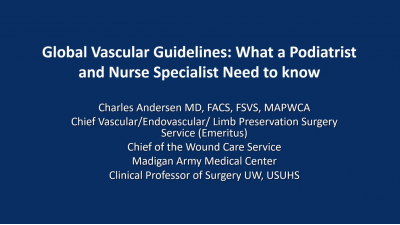
Practice Perfect 915
Patient Anxiety: A Rate Limiting
Factor in Successful Podiatric Care
Patient Anxiety: A Rate Limiting
Factor in Successful Podiatric Care

Years ago, I treated a patient with paranoid schizophrenia and diabetic neuropathy with recurrent ulcers. When I first started treating him, I would heal one wound only to find another soon after. As time progressed, he ended up with amputations of various sorts, and as you can imagine this led to further infections and more amputations. The last time I saw him he was about to receive a BKA on one side. While treating him, I found myself questioning what I was doing wrong. Why weren’t his ulcers healing as I would expect? Why the recurrences? I had checked all the factors responsible for nonhealing ulcers (infections, blood sugar control, arterial perfusion, mechanical issues, etc), but I still couldn’t figure out where I was failing. And then I learned that he was manipulating his feet, tearing at his skin, trying to rid himself of “little grey men.” I believe he was experiencing formication, that sense of crawling that happens with some neuropathies. His unfortunate mind turned these sensations into hallucinations leading to a number of anxiety-driven behaviors, ending in amputations.
Now, this is a somewhat extreme and tragic case, but it highlights one end of the anxiety spectrum. Over the years, I have learned – as I’m sure many providers are well aware – that patient anxiety is a remarkably powerful driver of disease and often has a significant effect on our surgical and nonsurgical outcomes.
One of the factors I regularly evaluate when determining the surgical approach for a patient is their overall level of anxiety. Occasionally, I’ll see a patient that comes across as too anxious to handle surgery, and I will emphasize a nonsurgical approach. In other patients with anxiety, I may opt for a smaller, more focused surgical procedure. For example, I’ve found that patients with significant anxiety don’t handle recovery after the Lapidus bunionectomy as well as they do a distal first metatarsal osteotomy. The longer healing timeframe with the associated swelling is just too much for them to handle.
Figuring out who is too anxious for certain treatments is a highly challenging aspect of patient care, and I’ll be the first to admit this is much more art than science. As a result of making too many wrong decisions with this patient population, I’ve built a small number of criteria to help find those red flags. These are by no means black and white, mandatory rules, but they have often come in handy.
- Get to know your patient - For all of my elective cases I make every attempt to understand my patient before scheduling the surgery with more than one appointment. I rarely schedule a surgery based on the initial visit. I’ll typically try some nonsurgical treatment, even if I think it’s likely to need surgery. This provides immediate treatment, while I get to know them better, testing to see how well they understand and follow instructions. Noncompliance with simple nonsurgical instructions is doomed to fail with the more complex postoperative recovery.
- Caution with a prior diagnosis of fibromyalgia - I don’t mean to disregard this diagnosis but rather understand that anxiety is a significant aspect of this disorder, making treatment for any musculoskeletal disease more difficult.
- Watch out for flat affect, lack of smile, and disengagement - By no means do our patients need to be happy go lucky giggling fools to convince us they do not suffer anxiety. However, most patients will interact in a generally social manner. It’s those patients with bland, poorly interactive mannerisms that are concerning.
- The red flag of too many questions - Now, I don’t mean to sound callous, but it is possible for a patient to ask too many questions. I commonly experience a patient that asks endless questions when discussing surgery, coopting too much clinic time, and this typically translates to problems postop. How many is too many? I don’t know. I’ll typically get a subjective feeling that the encounter has gone down a too detailed path, and I start thinking, “If this is the number of questions during the initial encounter how many will there be when we come closer to surgery?” A happy medium, with a patient asking questions to obtain a general understanding of a proposed procedure at the first visit is typically a good sign.
Going through this thought process does not cause me to say no to surgery or to treating a particular patient, but these red flags will alter my approach. In fact, in some cases I will discuss their apparent anxiety with a patient. “You seem very anxious. Do you think this might cause issues during your surgery?” is the type of statement that can start a reasonable conversation. If a patient is insulted by your honesty as a physician, then perhaps they’re not the right person on which to do surgery? The mind truly is a powerful driver of disease in our patients, and we should take it very seriously to provide those in our care with the safest, most humane treatment possible.
Best wishes.

Jarrod Shapiro, DPM
PRESENT Practice Perfect Editor
[email protected]

































Comments
There are 0 comments for this article